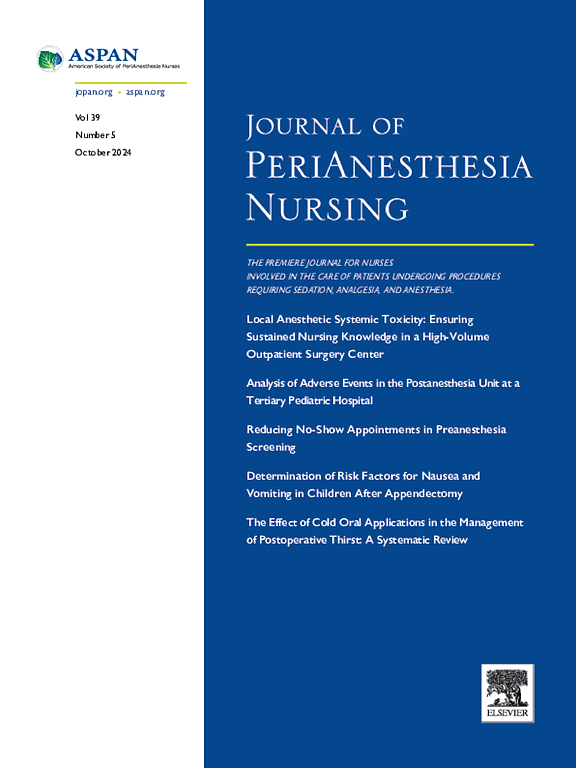优化推送通知系统,改善首例延误:质量改进项目。
IF 2
4区 医学
Q2 NURSING
引用次数: 0
摘要
目的:通过优化术前(术前)推送通知系统的使用,以减少延误并提高手术室效率,提高新英格兰一家大型医院的首次病例准时开诊率(FCOTS)。设计:该项目采用了由医疗保健改进研究所的改进模型指导的质量改进方法。方法:采用集成电子健康记录的推送通知系统,加强三个外科科室的外科医生和术前护士之间的沟通。为所有注册工作人员提供了强制性教育课程,并进行了计划-执行-研究-行动循环,以完善流程并监测结果。从实施前(2023年8月)到实施阶段(2023年12月),跟踪了通知使用和FCOTS率的数据。结果:培训导致87% (n = 60)的护士完成了推送通知教育,31% (n = 28)的外科医生确认阅读了培训材料。最初的实施使护士的推送通知使用率从26%提高到2023年10月的51%,尽管后来到年底下降到39%,净收益为17%。在外科医生中,推送通知的使用率最高达到18%,比基线净增长2%。东馆保持了相对较高的FCOTS率,从10月份的82%略微下降到年底的78%。在北馆和南馆,护士推送通知使用率的增加与FCOTS的逐步改善相一致:北馆从63%上升到65%,而南馆经历了波动,最终从基线增长了12%,在12月达到57%。结论:这些发现表明,虽然在护士中增加推送通知的使用有助于改善某些展馆的FCOTS,但有限的外科医生参与可能阻碍了减少延误的总体影响。未来的战略应侧重于提高所有员工的参与度,改善工作流程集成,并实施持续的绩效跟踪,以优化所有展馆的手术效率。加强FCOTS不仅可以通过减少等待时间和提高满意度来改善患者体验,还可以通过简化工作流程和减轻压力来使员工受益。最终,这些改进有助于提高围手术期护理的效率和成本效益。本文章由计算机程序翻译,如有差异,请以英文原文为准。
Optimization of a Push Notification System to Improve First-case Delays: A Quality Improvement Project
Purpose
To increase first-case on-time start (FCOTS) rates at a large New England hospital by optimizing the use of a preoperative (pre-op) push notification system to reduce delays and improve operating room efficiency.
Design
The project employed a quality improvement approach guided by the Model for Improvement from the Institute for Healthcare Improvement.
Methods
A push notification system integrated into the electronic health record was used to enhance communication between surgeons and pre-op nurses across three surgical pavilions. Mandatory education sessions were provided for all enrolled staff, and Plan-Do-Study-Act cycles were conducted to refine processes and monitor outcomes. Data on notification usage and FCOTS rates were tracked from pre implementation (August 2023) through the implementation phase (December 2023).
Findings
Training resulted in 87% (n = 60) of nurses completing the push notification education, and 31% (n = 28) of surgeons confirmed reviewing training materials. Initial implementation increased push notification use among nurses from 26% to a peak of 51% in October 2023, though this later declined to 39% by year-end with net gain of 17%. Among surgeons, push notification usage peaked at 18%, with a net gain of 2% over the baseline. The East pavilion maintained relatively high FCOTS rates, decreasing slightly from 82% in October to 78% by year-end. In the North and South pavilions, increased push notification usage by nurses aligned with gradual FCOTS improvements: the North pavilion rose from 63% to 65%, while the South pavilion experienced fluctuations, ultimately achieving a 12% increase from baseline to reach 57% in December.
Conclusions
These findings suggest that while increased push notification use among nurses helped improve FCOTS in some pavilions, limited surgeon participation may have hindered the overall impact on reducing delays. Future strategies should focus on increasing engagement from all staff, improving workflow integration, and implementing ongoing performance tracking to optimize surgical efficiency across all pavilions. Enhancing FCOTS not only improves the patient experience by reducing wait times and increasing satisfaction, but also benefits staff by streamlining workflows and reducing stress. Ultimately, these improvements support organizational goals for greater efficiency and cost-effectiveness in perioperative care.
求助全文
通过发布文献求助,成功后即可免费获取论文全文。
去求助
来源期刊

Journal of Perianesthesia Nursing
NURSING-
CiteScore
2.20
自引率
17.60%
发文量
279
审稿时长
90 days
期刊介绍:
The Journal of PeriAnesthesia Nursing provides original, peer-reviewed research for a primary audience that includes nurses in perianesthesia settings, including ambulatory surgery, preadmission testing, postanesthesia care (Phases I and II), extended observation, and pain management. The Journal provides a forum for sharing professional knowledge and experience relating to management, ethics, legislation, research, and other aspects of perianesthesia nursing.
 求助内容:
求助内容: 应助结果提醒方式:
应助结果提醒方式:


